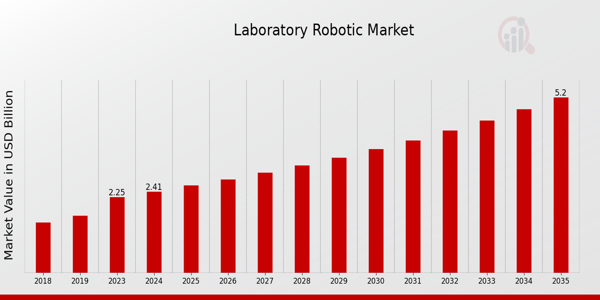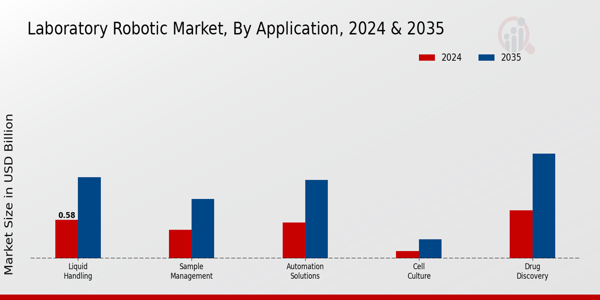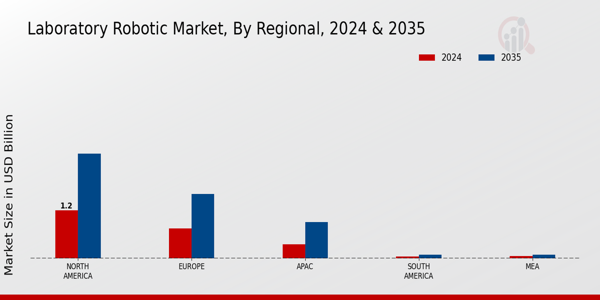Global Laboratory Robotic Market Overview
Laboratory Robotic Market Size was estimated at 2.25 (USD Billion) in 2023. The Laboratory Robotic Market is expected to grow from 2.41 (USD Billion) in 2024 to 5.2 (USD Billion) by 2035. The Laboratory Robotic Market CAGR (growth rate) is expected to be around 7.24% during the forecast period (2025 - 2035).
Key Laboratory Robotic Market Trends Highlighted
The growing demand for automation in laboratory procedures is propelling the laboratory robotics market's notable expansion. This is especially crucial now because efficiency and accuracy are crucial in research and development. Robotic solutions are in greater demand as laboratories look to improve productivity, lower operating costs, and decrease human error.
This tendency is also being fueled by an increase in research activity in a number of industries, such as biotechnology and pharmaceuticals. The demand for sophisticated laboratory robotics is further heightened by regulatory compliance and the desire for superior outcomes, as these systems provide dependability and consistent performance.
Opportunities abound in this evolving market, particularly in the integration of artificial intelligence and machine learning technologies. By incorporating these advanced technologies, laboratory robots can improve decision-making, enhance data analysis, and facilitate predictive maintenance.
Additionally, there is potential for growth in customized robotic solutions tailored to specific laboratory needs, allowing for greater flexibility in different research environments. As the demand for high-throughput screening and data management continues to grow, companies can leverage these trends to capture new market segments.
In recent times, there's been a noticeable shift towards collaborative robots, or cobots, which work alongside human operators. This trend reflects a growing preference for systems that can support laboratory personnel rather than replace them entirely.
Furthermore, advancements in miniaturization and mobility are making laboratory robots more accessible and user-friendly. The increasing emphasis on sustainability in lab operations is also prompting innovations that focus on reducing waste and energy usage.
Overall, the Laboratory Robotic Market is poised for transformative changes, presenting numerous pathways for innovation and growth.

Source: Primary Research, Secondary Research, MRFR Database and Analyst Review
Laboratory Robotic Market Drivers
Increasing Demand for Automation in Laboratories
The increasing demand for automation in laboratories is one of the most significant drivers of the Laboratory Robotic Market. Laboratories across various sectors, including healthcare, pharmaceuticals, biotechnology, and research institutions, are constantly looking for ways to enhance productivity and efficiency.
Automation not only speeds up processes but also minimizes human error, which is critical in laboratory environments where accuracy is paramount. As lab professionals seek to alleviate repetitive tasks, the integration of robotic systems becomes essential. The growing trend of high-throughput screening in drug discovery and the need for standardized processes has led organizations to invest in robotic solutions.
Enhanced robotic capabilities allow labs to perform tasks such as sample analysis, liquid handling, and preparation with greater precision and speed, ultimately resulting in improved outcomes and the ability to handle larger volumes of work.
Furthermore, the push towards laboratory automation is driven by the need for compliance with regulatory requirements, where systems must ensure consistent and auditable results. In light of the projected market growth, laboratories are expected to increasingly adopt robotic technologies, leading to a more automated future with better resource management and streamlined workflows.
Technological Advancements in Robotics
Technological advancements play a crucial role in fostering growth within the Laboratory Robotic Market. Innovations in robotic designs, artificial intelligence, machine learning, and integration with other advanced technologies have significantly enhanced the capabilities of laboratory robots.
These advancements enable robots to perform complex tasks that were previously unimaginable, such as intricate sample analysis and automated data gathering. As technology continues to evolve, robotic systems become more efficient, user-friendly, and adaptable to different laboratory environments, making them appealing to a wider range of customers.
Rising Investment in Research and Development
The rising investment in research and development (R) initiatives across various industries significantly fuels the Laboratory Robotic Market. Organizations are committing substantial resources to improve lab efficiency and foster innovation, which in turn increases the demand for robotic solutions that optimize research processes.
As research becomes increasingly competitive, companies recognize the importance of sophisticated laboratory automation to enhance their capabilities and achieve faster results. This trend encourages the adoption of advanced laboratory robots, driving market growth.
Laboratory Robotic Market Segment Insights
Laboratory Robotic Market Application Insights
The Laboratory Robotic Market, particularly focusing on the application segment, witnessed significant growth. This segment was crucial as it encompassed various essential applications designed to enhance laboratory efficiency and accuracy.
One of the key applications, Liquid Handling, was valued at 0.584 USD Billion in 2024, anticipated to grow to 1.228 USD Billion by 2035. This application demonstrated majority holding in the market, as liquid handling systems streamlined processes such as dispensing, mixing, and dosing, thereby increasing throughput and precision, essential in modern laboratories.
Another important area was Sample Management, valued at 0.438 USD Billion in 2024 and expected to reach 0.903 USD Billion by 2035. This application was significant as it optimizes sample storage, retrieval, and tracking, which were critical functions in both research and clinical labs, ensuring that samples were not only preserved but also easily accessible for analysis.
Automation Solutions were also a vital part of the market, with a valuation of 0.548 USD Billion in 2024, projected to grow to 1.192 USD Billion by 2035. Automation Solutions played a pivotal role in reducing human error and increasing throughput, thus driving efficiencies in various lab operations.
The Cell Culture application represented a smaller yet important facet, valued at 0.11 USD Billion in 2024 and expected to reach 0.289 USD Billion in 2035. This application was increasingly significant as it supported the growing demand for cell-based assays and drug development processes.
Lastly, Drug Discovery stood out as a major segment, projected to grow from 0.73 USD Billion in 2024 to 1.589 USD Billion by 2035, highlighting its importance in the pharmaceutical industry, where laboratory robots were essential for accelerating the discovery and testing of new drugs.
The features of these applications drove the overall growth of the Laboratory Robotic Market, addressing the modern demands for speed, precision, and accuracy in laboratory environments. Moreover, as laboratories seek to cope with the increasing complexity of tasks and data, the automation of these applications presents opportunities for further innovation and development within the industry.
Overall, the consistent growth projected across these applications underscores their critical role in enhancing laboratory operations, improving outcomes in clinical and research settings, and positioning the Laboratory Robotic Market for substantial advancements in the coming years as technology continues to evolve and improve.

Source: Primary Research, Secondary Research, MRFR Database and Analyst Review
Laboratory Robotic Market Product Type Insights
Within this market, the Product Type segmentation demonstrates a variety of components that cater to laboratory automation needs. Robotic Arms hold a significant position due to their versatility in performing complex tasks, while Liquid Handling Systems are essential for precision in sample analysis and reagent dispensing, thereby improving workflow efficiency.
Automated Workstations streamline multiple processes, reducing human intervention and error rates, and are increasingly favored in biological and pharmaceutical labs. Additionally, Sample Storage Systems serve a critical role in maintaining sample integrity and accessibility, which is vital for various research applications.
The rise in demand for automation in laboratory settings, driven by the need for accuracy and high-throughput capabilities, is propelling the market forward. Challenges such as high initial costs and integration complexities remain, but technological advancements present substantial opportunities for innovation and expansion within the Laboratory Robotic Market.
Market growth is being supported by ongoing trends towards automation and digitalization, reflecting in the Laboratory Robotic Market statistics and overall revenue projections from 2025 to 2035.
Laboratory Robotic Market End User Insights
The market is notably driven by significant players in the End User segment, including pharmaceutical companies and biotechnology firms, which are increasingly adopting robotic solutions to enhance accuracy and efficiency in laboratory processes.
Academic and research institutions rely on advanced robotics for high-throughput screening, streamlining complex experiments, and obtaining precise results, thus fostering innovation in scientific research. Meanwhile, diagnostic laboratories are utilizing robotic systems for rapid sample processing and analysis, which substantially improves diagnostic turnaround times.
The Laboratory Robotic Market revenue is bolstered by these pivotal players, as their demand for automation tools continues to rise. As market growth continues, understanding the Laboratory Robotic Market segmentation is essential for stakeholders looking to capitalize on emerging opportunities in this expanding field.
The expected development in robotics technology and automation solutions presents a promising landscape for future advancements in the industry.
Laboratory Robotic Market Component Insights
The Component segment of the Laboratory Robotic Market has shown robust growth, contributing significantly to the overall valuation. This segment encompasses various vital elements, including Hardware, Software, and Services, playing crucial roles in enhancing laboratory automation efficiency.
Hardware solutions, which include robotic arms and automated workstations, have seen vast applications in laboratories, facilitating precision and speed in experiments. Similarly, Software solutions are increasingly critical, enabling seamless integration and operation of robotic systems, providing software management tools essential for data management.
Additionally, Services within this segment are vital for operational maintenance and support, ensuring that robotic systems function optimally. The combination of these components drives substantial market growth as the demand for automation increases in laboratories worldwide, shaped by the trends of efficiency and precision in scientific research.
The majority of the Laboratory Robotic Market revenue stems from Hardware, underscoring its importance in lab environments where precision is paramount. Software solutions are also significant as they enhance interoperability among advanced robotic systems, allowing for streamlined processes.
Services, meanwhile, are essential for sustaining the entire robotic ecosystem, providing necessary support to laboratories transitioning to automated environments.
The interplay between these components is vital for addressing current industry demands and advancing laboratory capabilities. The market continues to adapt to healthcare innovations and scientific advancements, adding further dynamics to the Laboratory Robotic Market.
Laboratory Robotic Market Regional Insights
The Laboratory Robotic Market witnessed substantial growth across various regions, with North America leading the way in terms of market valuation. In 2024, North America was valued at 1.2 USD Billion, representing a majority holding in the overall market. This region's dominance can be attributed to strong technological advancements and high investments in research and development.
Europe followed with a value of 0.75 USD Billion in 2024, driven by the increasing adoption of automation in laboratories and a growing focus on efficiency. The Asia-Pacific (APAC) region, valued at 0.35 USD Billion, experienced significant growth due to rising demand for advanced laboratory technologies and expanding biopharmaceutical sectors.
South America and the Middle East Africa (MEA) held lower market valuations at 0.05 USD Billion and 0.06 USD Billion, respectively, highlighting their emerging status in the Laboratory Robotic Market. Despite their size, these regions offered opportunities for growth as they began to adopt laboratory robotics to enhance productivity and workflow efficiencies.
The overall market statistics and segmentation indicated a promising outlook for automation in laboratory settings, driven by technological innovations and increasing healthcare demands.

Source: Primary Research, Secondary Research, MRFR Database and Analyst Review
Laboratory Robotic Market Key Players and Competitive Insights
The Laboratory Robotic Market is characterized by a dynamic landscape where various players strive to establish a competitive edge through technological advancements and innovative solutions. This market is driven by the increasing demand for automation in laboratory environments, primarily to enhance efficiency, accuracy, and throughput in processes.
Competitive insights reveal that companies are focusing on research and development to create sophisticated robotic systems and software that streamline laboratory workflows.
The quest for collaborative partnerships and strategic acquisitions has intensified as organizations aim to expand their product portfolios and penetrate new markets. Overall, the competitive environment is heavily influenced by rapid technological innovations, regulatory compliance, and the need for high-quality performance in laboratory operations.
Abbott Laboratories has made significant strides in the Laboratory Robotic Market by leveraging its strengths in technology and innovation. The company is recognized for its robust portfolio of advanced laboratory instruments and automation solutions that enable high-throughput testing and accurate diagnostics.
Abbott Laboratories underscores its commitment to enhancing laboratory efficiency through integrated robotic systems that minimize human intervention and errors. The company's extensive research capabilities facilitate the continuous improvement of its robotic technologies, which cater to diverse applications, including clinical chemistry, immunoassay, and molecular diagnostics.
Furthermore, Abbott's strong global presence and established brand reputation contribute to its competitive advantage, allowing it to capture a significant market share and build lasting relationships with healthcare providers and research institutions.
Roche Diagnostics plays a pivotal role in the Laboratory Robotic Market by offering a holistic range of automation solutions designed to optimize laboratory workflows. The company is well-known for its innovative robotic systems that enhance productivity and yield in various diagnostic processes.
Roche Diagnostics emphasizes collaboration with healthcare facilities to tailor its automation platforms according to specific laboratory needs, which strengthens customer loyalty and satisfaction. The firm's commitment to advancing precision in medical diagnostics through state-of-the-art technologies positions it as a formidable competitor in the market.
Roche's focus on integrating artificial intelligence and machine learning into its robotic solutions further enhances its market proposition, enabling laboratories to achieve greater throughput and accuracy while reducing turnaround times for test results. This strategic emphasis on innovation and customer-centric solutions bolsters Roche Diagnostics' standing as a leader in the laboratory robotics domain.
Key Companies in the Laboratory Robotic Market Include
- Abbott Laboratories
- Roche Diagnostics
- Becton Dickinson and Company
- Thermo Fisher Scientific
- Beckman Coulter
- BioRad Laboratories
- Eppendorf
- Tecan Group
- Agilent Technologies
- Waters Corporation
- Sartorius AG
- Siemens Healthineers
- Merck Group
- PerkinElmer
- Hamilton Company
Laboratory Robotic Market Developments
Recent developments in the Laboratory Robotic Market have shown significant advancements in automation technologies, emphasizing the importance of efficiency and accuracy in laboratory settings. Companies like Abbott Laboratories and Roche Diagnostics continue to innovate their robotic solutions to streamline workflows and enhance productivity.
Becton Dickinson and Company recently reported an increase in demand for their automated liquid handling systems, which has positively impacted their market valuation. Thermo Fisher Scientific and Beckman Coulter are also expanding their robotic offerings through strategic partnerships.
Moreover, BioRad Laboratories and Eppendorf have seen growth in their robotic platforms, catering to the rising need for high-throughput screening in research institutions.
In terms of mergers and acquisitions, Tecan Group's recent acquisition of a complementary technology company bolsters its position in the laboratory automation space, while Agilent Technologies has strengthened its portfolio by acquiring a firm specializing in laboratory robotics.
Siemens Healthineers and Merck Group are also collaborating on innovative solutions aiming for improved integration in laboratory automation. The market is witnessing an upward trend in investments as firms seek to enhance their capabilities, thereby driving growth in the Laboratory Robotic Market.
Laboratory Robotic Market Segmentation Insights
-
Laboratory Robotic Market Application Outlook
- Liquid Handling
- Sample Management
- Automation Solutions
- Cell Culture
- Drug Discovery
-
Laboratory Robotic Market Product Type Outlook
- Robotic Arm
- Liquid Handling System
- Automated Workstation
- Sample Storage System
-
Laboratory Robotic Market End User Outlook
- Pharmaceutical Companies
- Biotechnology Firms
- Academic and Research Institutions
- Diagnostic Laboratories
-
Laboratory Robotic Market Component Outlook
- Hardware
- Software
- Services
-
Laboratory Robotic Market Regional Outlook
- North America
- Europe
- South America
- Asia Pacific
- Middle East and Africa
|
Report Attribute/Metric
|
Details
|
|
Market Size 2023
|
2.25(USD Billion)
|
|
Market Size 2024
|
2.41(USD Billion)
|
|
Market Size 2035
|
5.2(USD Billion)
|
|
Compound Annual Growth Rate (CAGR)
|
7.24% (2025 - 2035)
|
|
Report Coverage
|
Revenue Forecast, Competitive Landscape, Growth Factors, and Trends
|
|
Base Year
|
2024
|
|
Market Forecast Period
|
2025 - 2035
|
|
Historical Data
|
2019 - 2024
|
|
Market Forecast Units
|
USD Billion
|
|
Key Companies Profiled
|
Abbott Laboratories, Roche Diagnostics, Becton Dickinson and Company, Thermo Fisher Scientific, Beckman Coulter, BioRad Laboratories, Eppendorf, Tecan Group, Agilent Technologies, Waters Corporation, Sartorius AG, Siemens Healthineers, Merck Group, PerkinElmer, Hamilton Company
|
|
Segments Covered
|
Application, Product Type, End User, Component, Regional
|
|
Key Market Opportunities
|
Increased automation in laboratories, Rising demand for precision medicine, Expanding biopharmaceutical research activities, Growing need for high-throughput screening, Advancements in AI and machine learning
|
|
Key Market Dynamics
|
Automation adoption in laboratories, Increasing demand for high-throughput solutions, Growing emphasis on precision and accuracy, Rising labor costs and skill shortage, Advancements in AI and machine learning
|
|
Countries Covered
|
North America, Europe, APAC, South America, MEA
|
Frequently Asked Questions (FAQ) :
The Global Laboratory Robotic Market is expected to be valued at 2.41 USD Billion in 2024.
By 2035, the Global Laboratory Robotic Market is expected to reach a valuation of 5.2 USD Billion.
The expected compound annual growth rate (CAGR) for the Global Laboratory Robotic Market is 7.24% from 2025 to 2035.
North America is projected to have the largest market size at 1.2 USD Billion in 2024.
The anticipated value of the Global Laboratory Robotic Market in the Asia-Pacific region is 0.9 USD Billion by 2035.
The Drug Discovery application segment is expected to grow significantly, reaching 1.589 USD Billion by 2035.
Major players in the Global Laboratory Robotic Market include Abbott Laboratories, Roche Diagnostics, and Thermo Fisher Scientific.
The Liquid Handling application segment is expected to be valued at 0.584 USD Billion in 2024.
The Sample Management segment is expected to grow from 0.438 USD Billion in 2024 to 0.903 USD Billion by 2035.
Key opportunities for growth in the Global Laboratory Robotic Market include advancements in automation solutions and increased demand from drug discovery processes.

















